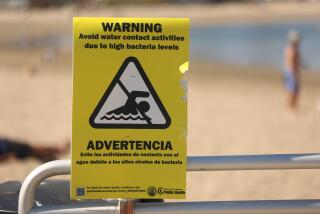Most Beaches Set to Reopen After Huge Sewage Spill
- Share via
An 11-mile stretch of Santa Monica Bay remained closed for a fourth day because of a massive sewage spill, but officials said most of the beaches will reopen this morning.
And environmentalists led by Heal the Bay called Wednesday on the county sanitation district to retrofit all pumping stations with underground storage facilities that would capture leaking sewage that would otherwise flow into streets, flood control channels, the beach and the ocean.
The Los Angeles County Board of Supervisors has ordered sanitation officials to prepare a detailed report on how to prevent a repeat of Sunday’s spill -- the largest in a decade.
And an official with the Los Angeles Regional Water Quality Control Board confirmed Wednesday that the agency will be investigating the incident, although he declined to give details or possible penalties.
Calls for better pumps and warning systems have also come from leaders of some beach cities after more than 2 million gallons of raw sewage spilled from a Manhattan Beach pumping plant after an apparent power failure. As much as 100,000 gallons flowed onto beaches, officials estimated.
“There’s no reason that a power outage should cause this type of spillage,” said Manhattan Beach Mayor Mitch Ward. “We don’t want this to happen again because the beaches and ocean as well as the environment here in Manhattan Beach are precious.”
A series of electrical snafus caused the station to shut down and sewage to back up. An alarm system designed to alert sanitation officials of such a problem failed.
Ward reserved his harshest criticism for the malfunctioning telephonic alarm system.
The mayor said the system was down for 28 hours from the time of the spill. That system would have notified authorities that a pumping station on 27th Street had lost power.
The telephone carrier, Verizon, confirmed through a spokesman that it was investigating the problem. Verizon believes the line was down for five hours initially, went back into service and then failed again for an undetermined period, said spokesman Jon Davies.
Ward, who also serves on the county sanitation board, rejected the idea of building catch basins, which he said were not realistic -- or cost effective.
“With the number of redundant systems there is no reason to dig a hole to address the spillage after the fact,” Ward said.
Sanitation officials have not pinpointed a cause for the spill but they are focusing on a faulty electrical power source for pumps at the 27th Street pumping station.
Although most of the mess was contained in a football field-size stretch of sand in Manhattan Beach, sanitation district officials have conceded that thousands of gallons may have entered the ocean. Sewer water and muck also flowed into at least two homes in Hermosa Beach.
Los Angeles County Sanitation District spokesman Joe Halworth said the agency was moving as quickly as possible to fix the system.
Earlier this month, the agency began upgrading aging electrical controls panels at the pumping station. It is also installing an alarm system that would pinpoint problems at each of the 20 South Bay pumping stations.
Those steps are also part of a larger effort to upgrade 44 stations with more modern technology, including allowing workers in Long Beach to automatically control the pumping of sewage.
But Mark Gold, head of the environmental group Heal the Bay, said Wednesday that despite all the promises, he was concerned about how long it was taking the county to pinpoint a cause.
“The fact that we are at Day 4 without having any valid explanation of how the spill occurred is extremely disturbing,” Gold said. “Especially if you live or surf in the South Bay.”
Gold was also critical of the county Department of Health Services for not testing ocean water near the spill zone until Monday night, 18 hours after the spill.
According to testing done by the sanitation district, the highest readings were recorded about 9 p.m. Sunday.
In a briefing to the Board of Supervisors, county public health officials said the spill caused “a relatively small” increase in risk from the high levels in total coliform bacteria found in the area most affected by the spill -- at 21st Street and the Strand in Manhattan Beach.
More to Read
Sign up for Essential California
The most important California stories and recommendations in your inbox every morning.
You may occasionally receive promotional content from the Los Angeles Times.













